The Emerging Leader in Spectroscopy Award
Spectroscopy
This year’s Atomic Spectroscopy award recipient, Jake Shelley, focuses on the development of plasma-based tools for mass spectrometry, which enable rapid and sensitive detection and identification of a broad range of analytes from complex matrices.
This year’s Atomic Spectroscopy award recipient, Jake Shelley, focuses on the development of plasma-based tools for mass spectrometry, which enable rapid and sensitive detection and identification of a broad range of analytes from complex matrices.
Jacob T. (“Jake”) Shelley is the Alan Paul Schulz Professor of Chemistry in the Department of Chemistry and Chemical Biology at Rensselaer Polytechnic Institute (RPI) in Troy, New York. He is the winner of the 2020 Emerging Leader in Atomic Spectroscopy Award, which will be presented by Spectroscopy at the Winter Conference on Plasma Spectrochemistry the week of January 12–18, 2020, in Tucson, Arizona.
The Spectroscopy Emerging Leader in Atomic Spectroscopy Award recognizes the achievements and aspirations of a talented young atomic spectroscopist who has made strides early in his or her career toward the advancement of atomic spectroscopy techniques and applications. The winner must be within 10 years of receiving his or her highest academic degree in the year the award is granted.
Shelley earned his undergraduate degree from Northern Arizona University, and received his PhD in 2011 from Indiana University under Professor Gary M. Hieftje. Following postdoctoral research at Purdue University (mentored by Prof. R. Graham Cooks), and the University of Münster (under Prof. Uwe Karst and Prof. Carsten Engelhard), he then became an assistant professor at Kent State University in 2014. In 2016, he was appointed the Alan Paul Schulz Career Development Professor of Chemistry at RPI.
Shelley has published more than 41 peer-reviewed papers and one book chapter, holds five patents and patent applications, and has presented more than 60 papers and invited talks at scientific conferences. He has specialized in the development of atmospheric-pressure plasmas as ionization sources for atomic, molecular, and biological mass spectrometry.
Shelley giving his plenary lecture at the 2015 European Winter Conference on Plasma Spectrochemistry (EWCPS) in Munster, Germany (photo courtesy of Uwe Karst).
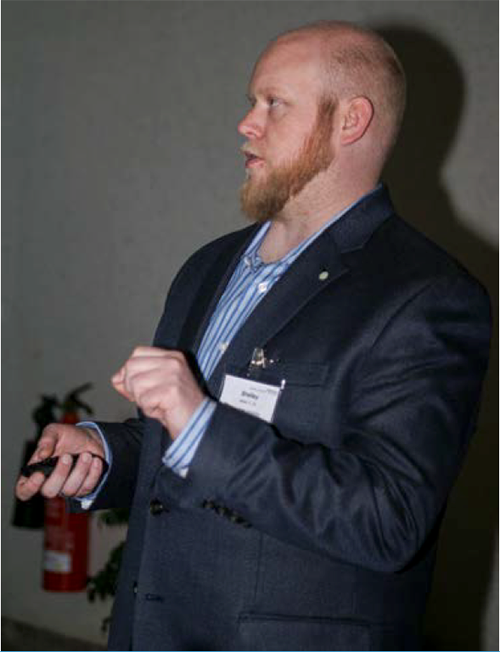
He has received multiple awards and scholarships, including the Gordon F. Kirkbright Bursary Award from the Association of British Spectroscopists; the Tagungsstipendium Analytische Chemie of the German Chemical Society (twice); a Humboldt Research Fellowship of the Alexander von Humboldt Foundation; and the Bunsen-Kirchhoff Award.
With an impressive h-index of 23, Shelley’s research explores new and advanced desorption and ionization mechanisms of plasma-based sources for mass spectrometry applications and instrumentation. As a student at Indiana University and since, Shelley has published in such diverse and prestigious journals as Mutagenesis, Biometals, Analytical Chemistry, Microporous and Mesoporous Materials, The Journal of Analytical Atomic Spectrometry, Journal of the American Society for Mass Spectrometry, Analyst, and Rapid Communications in Mass Spectrometry.
His volunteer activities are diverse. He was on the conference organizing committee for the 2017 Ionization Principles in Organic and Inorganic Mass Spectrometry conference in Menorca, Spain. He has acted as chair and organizer for five invited symposia at Pittcon (in 2012, 2013, 2015, 2017, and 2018) and for eleven invited sessions at the Federation of Analytical Chemistry and Spectroscopy Societies (FACSS) Conference/SciX Conference (2009–2019). He also acts as a referee for a number of journals, including Nature, Analytical Chemistry, Analyst, Rapid Communications in Mass Spectrometry, Journal of the American Society for Mass Spectrometry, Journal of Analytical Atomic Spectroscopy, Analytica Chimica Acta, and Spectrochimica Acta Part B: Atomic Spectroscopy.
Karst, of the University of Münster, was a postgraduate mentor of Shelley’s. “Dr. Shelley’s record and achievements are outstanding,” he says. “He is among the top-notch young investigators in the field.”
Hieftje, a Distinguished Professor Emeritus and the Mann Chair of Chemistry at Indiana University, who was Shelley’s PhD supervisor, said that Shelley and his group have already made a number of significant contributions to spectroscopy. “Among them, I would rank highest his exploration of the combination of a solution-cathode glow discharge (SCGD) with mass spectrometry (MS),” he said. He also said that Shelley is inquisitive, objective, and determined, which are important qualities for scientific inquiry.
Cooks, the Henry Bohn Hass Distinguished Professor of Chemistry in the Aston Laboratory of Mass Spectrometry at Purdue University, is also impressed with Shelley. “What struck me most about Jake, when I started to collaborate with him a decade ago, was the speed with which he worked-and his broad knowledge of physics, plasmas, and instrumentation,” he said. “He has clearly emerged as a leader in atomic spectroscopy, and this is further testament to the quality of his training under Gary Hieftje at Indiana University, as well as his native ability.”.
Since 2008, George Chan, a research scientist at Lawrence Berkeley National Laboratory, has worked closely with Shelley on plasma-based ambient desorption ionization mass spectrometry (ADI-MS); they have collaborated on six research articles. Chan also considers Shelley’s greatest contributions to be his work on coupling an SCGD source to MS. This development took a source initially developed for atomic emission and coupled it to a mass spectrometer. “Jake showed its vast potential, not only for elemental analysis, but also for high-precision isotopic-ratio analysis as well as for biochemical analysis (peptide fragmentation),” Chan said. Chan was impressed with the precision in isotope-ratio analysis that was achieved. Using a 5-min analysis time, Shelley’s SCGD-MS technique met the international target values (ITVs) set by the International Atomic Energy Agency (IAEA) for analytical precision used in assaying uranium enrichment, and was also able to detect trace amounts of 234-U and 236-U. “The very impressive example that Jake showed is the use of the SCGD-MS (again, a source that originally designed for atomic analysis) for peptide fragmentation,” he says. “Not only can the SCGD source fragment peptides, the spectral interpretation is generally simpler than those generated from other ion sources.” In some cases, Chan notes, the amino acid sequence can be read directly.
Shelley at work near his mass spectrometer during his early graduate work at Indiana University (photo courtesy of Gary M. Hieftje).
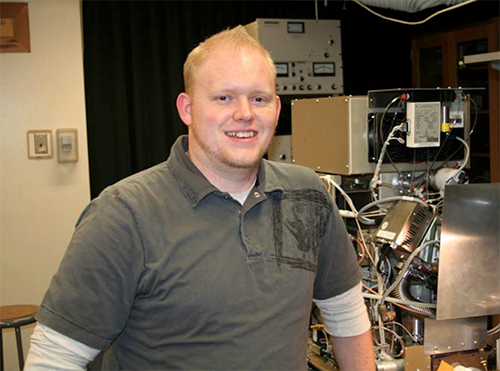
Plasma-Based Tools for Mass Spectrometry
Steven Ray, the Winkler Assistant Professor of Chemistry at the State University of New York at Buffalo, remarked on the value of Shelley’s work on plasmas. “Jake recognized very early on in the development of ambient ionization sources that understanding the fundamental mechanisms by which molecules are sampled, then ionized, was going to be critical to fruitful application,” he said. “He has a deep understanding of the mechanistics of gas-phase ion chemistry and the fundamentals of plasmas, and it is the ability to work in both fields that provides him with insights that others do not see.”
Fundamental Research in Understanding the Physics and Chemistry Underlying ADI-MS
In 2010, Shelley and Hieftje published research focusing on the detailed chemical and physical properties of ADI-MS (1). Their work delved into the underlying science behind desorption and ionization phenomena, as well as the issues associated with sample matrix effects inherent in plasma-based sources. ADI-MS seeks to eliminate sample pretreatment and separation steps for mass spectrometry analysis. The challenge in applications of ADI-MS is dealing with matrix effects. This research evaluated three plasma-based ADI-MS sources: a low-temperature plasma (LTP) probe, a flowing atmospheric-pressure afterglow (FAPA) source, and a direct analysis in real time (DART) source. The main area of study involved ion-suppression events, which typically result in a decrease in analyte signal. It was discovered that the FAPA source was least affected by ion suppression when proton-transfer ionization occurs. The research demonstrated that understanding the fundamental issues of matrix effects is essential to accurately applying ADI-MS for both quantitative and qualitative analysis.
Karst cites this work among Shelley’s most significant contributions to date. “Jake is a pioneer in the development of and applications with FAPA as a new ambient ionization source for pharmaceutical, forensics, and environmental applications of mass spectrometry,” he says.
Shelley showing the details of a FAPA source placed at the inlet of a mass spectrometer, in November 2007 (photo courtesy of George Chan).
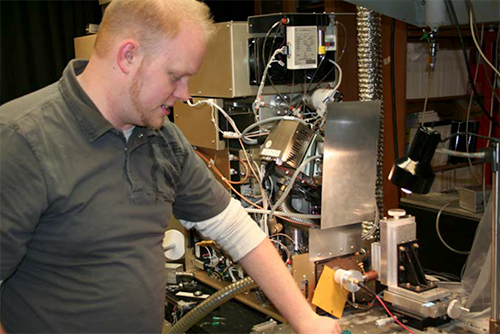
In related research, Shelley and coworkers recognized the critical role of the helium dimer ion (He2+) in the formation of the afterglow of a helium-based dielectric-barrier discharge (2). They conducted studies to understand the reaction mechanisms in the afterglow and reagent-ion formation for plasma-based ionization sources used in ambient MS. This work on the dielectric-barrier discharge of the LTP probe determined the roles of the helium dimer ion (He2+). This ion carries energy from the plasma discharge into the afterglow region, and it promotes charge transfer between He2+ and atmospheric nitrogen to form N2+. The N2+ ion is the key reaction intermediate in the formation of other important reagent ions, particularly protonated water clusters. In this work, the charge-transfer reaction between He2+ and N2 was described in detail, as well as the origin of excited atomic helium in the afterglow region of the LTP.
Shelley and his group then developed a handheld, wireless LTP source for MS (3). This device is based on a dielectric-barrier discharge. This ambient ionization source was demonstrated on a miniature mass spectrometer. The battery-powered (7.4-V Li-polymer battery) source uses mini-helium and air cylinders as its source of discharge gas. The work demonstrated that the handheld source was not only more efficient, and easier to set up, but also showed improved analytical performance over large-scale laboratory LTP sources. The battery power is capable of providing plasma for 2 h of continuous use, while meeting all other requirements for an LTP source.
The concept of a tunable FAPA plasma ionization source for MS was also devised by Shelley and coworkers (4). This specific work addressed new ways to control or adjust the ionization chemistry by changing the working conditions of the source. They found that gas flow rates and discharge currents could be adjusted to change the abundance of proton-transfer reagent ions. A nonpolar analyte, biphenyl, was used as a model compound, and was found to exhibit significant changes in its ionization pathway, depending on the operating parameter settings of the source. The tunable ionization modes for the FAPA source allowed detection of analytes that typically have poor sensitivity in applications of plasma-based ADI-MS. This tunable process increases the number of detectable analytes by improved sensitivity and reduced
matrix effects.
Engelhard, a professor of Analytical Chemistry at the University of Siegen, in Germany, notes that Shelley’s particular knowledge of electronics facilitates all his work on ambient ionization sources. “Even though mass spectrometers typically come with electrospray sources and are not ready to be used with custom-built ambient desorption/ionization sources, Jake can defeat any interlock in a heartbeat,” he said. “He can put a FAPA source virtually on any mass spectrometer.”
In a recent review article on trends and developments in ADI-MS (5), Shelley noted that key research is focused on sample introduction and preparation strategies, removing matrix effects, and multimode ionization sources, as well as pursuing applications in quantitative mass spectrometry and imaging.
Extending the Reach of Ambient Sampling Mass Spectrometry
Shelley’s research has also extended into modern “-omics”, such as metabolomics, proteomics, and glycomics, with a focus on electrospray ionization and tandem MS to identify the structures of target species (6). Rather than rely on specialized MS instrumentation, Shelley and coworkers developed a novel approach enabling ionization and controlled, tunable fragmentation of peptides at atmospheric pressure. The new source that he and his team developed uses a direct-current plasma, which is sustained between a tapered metal pole and a flowing sample solution. The liquid stream is placed in contact with an electrical discharge that is able to volatilize peptides in the sample, prior to being further ionized and fragmented in the plasma. When using high discharge currents of 70 mA or more, the spectra resemble those of electrospray techniques. Such spectra have the dominant features of singly and doubly protonated molecular ions; at lower currents, near 35 mA, the peptides are fragmented into fragment types not previously observed at atmospheric pressure. This technique and the theory behind it are still under exploration.
Some of this work has also led to patent filings and issued patents. In an issued US patent, for example, Shelley and coworkers describe a method for determining counterfeit electronic components using surface analysis via ambient sampling mass spectrometry and chemometric analysis (7). The method desorbs and ionizes material from the surface of a test sample without pretreatment. The resultant ions are detected and compared to known standards. The final result yields a confidence number related to a true or counterfeit electronic component. In other work, representing a break from fundamental research in plasma-based ambient mass spectrometry, Shelley and colleagues described a novel use of metal–organic cages (MOCs) to encapsulate Pt-based anticancer agents forming drug-containing nanoparticles for improved drug delivery (8).
In his most recent research, Shelley and his team have demonstrated rapid analysis of solid metal complexes by coupling a FAPA source with differential mobility spectrometry–mass spectrometry (DMS-MS) (9). Metal-ligand complexes are important for environmental, security, industrial, and biological applications. A hybrid system was constructed and shown to be able to perform quantitative analysis of nickel acetylacetonate. This analysis was performed following deposition of nickel acetylacetonate complexes on mesh substrates. It is essential that any analytical method for this type of application be capable of performing analyses in situ. This further requires the development of field screening devices based on portable mass spectrometry (MS). Thus, FAPA sources are of high interest as portable tools. However, a limitation of FAPA alone may be the matrix effects of ambient chemicals interfering with the analyte of interest, leading to false positives. To reduce interference, DMS was used to enable additional post-ionization separation. To provide the optimum design, a FAPA desorption/ionization source was coupled with DMS for metal-ion speciation. The coupled FAPA-DMS device was able to separate and detect cobalt and nickel complexes with acetylacetonate in standard mixtures. The results of this research suggest a method for in situ applications for inorganic complex analyses.
Presentation of the Bunsen-Kirchhoff-Award of the German Chemical Society (GDCh) to Shelley at the 2017 ANAKON conference. (L to R) Dr. Martin Greber (Perkin Elmer), Prof. Jacob T. Shelley, Prof. Kerstin Leopold (DAAS GDCh), Dr. Wolfgang Buscher (DAAS GDCh) (photo courtesy of Carsten Engelhard).
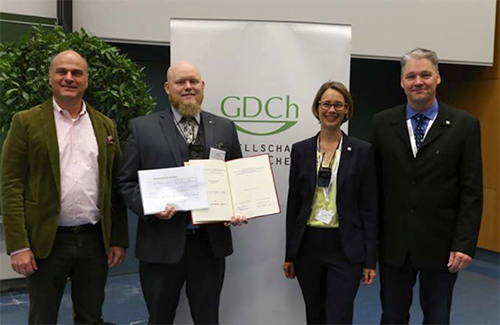
In further research on ambient MS, Shelley and his group applied cross-correlation data analysis for improved background removal and analyte-ion recognition (10). A cross-correlation–based approach was used to extract chemical information within time domain data to identify mass-spectral peaks within a single analysis dataset. Ions originating from background or ambient species were detected and removed from the mass spectra. The result of the chemometric process was to simplify the mass spectra by removing 70% of the complexity arising from background ions. The process not only removes background ions, but is able to differentiate and categorize analyte ions based on their time-domain profiles. In some cases, this mathematical process removed more than 98% of spurious mass-spectral complexity. The cross-correlation approach was tested for varying sample introduction systems, as well as for different ionization sources. The fully automated data processing approach, which was written inhouse, can be completed within a few seconds. This approach provides a powerful additional tool for analyte separation for single mass-spectrometric analysis runs.
Engelhard cited this work among Shelley’s most important contributions so far. “Jake’s approach simplifies analyte identification in complex samples, especially in non-targeted analysis, and provides an additional dimension of analyte separation,” he says. “A brilliant study, and a great contribution to our field.”
Shelley’s group has also extended the application of plasma-based ADI-MS for the analysis of liquid-crystal displays (LCDs), (11). LCDs are globally the most widely used display technology in use today. Because the precise chemical composition of LCDs is critical to their long-term performance, many analytical techniques have been employed for quality analysis of LCDs, including gas chromatography–mass spectrometry (GC–MS), time-of-flight secondary ion mass spectrometry (TOF-SIMS), high-resolution microscopy, and high-performance liquid chromatography (HPLC). Shelley’s research has shown that ADI-MS can provide faster, accurate, and less expensive analysis.
Personal Qualities
Many in the community also remarked on Shelley’s personal qualities, including his ability to bring scientists together. R. Kenneth (Ken) Marcus, the University Professor of Chemistry at Clemson University, says that Shelley has a unique ability to work with diverse teams of measurement scientists-atomic spectroscopists, mass spectrometrists, and metallomics researchers.
Karst agrees. “Dr. Shelley is one of the rare persons who combine a very positive personality with an unusual capability of critical thinking and the ability to critique in a way which is understood by others as extremely helpful, stimulating, and encouraging, rather than offensive,” he said, adding that Shelley has “a love for science, a passion for teaching, and an enjoyable personality.”
Shelley’s speaking skills have also won him praise. Karst called Shelley “a truly outstanding lecturer,” an impression that led Karst to invite him to give a plenary lecture at the European Winter Conference on Plasma Spectrochemistry in 2015, which was held at the University of Münster.
Maria Montes Bayón, a professor of analytical chemistry at the University of Oviedo, in Spain, agrees. “Didactically, Jake is excellent,” she said. “And simultaneously, he is entertaining while going deep into the science he is explaining.”
Englhard also raised this point. “Jake has the ability to explain what he does in the lab very efficiently, not only to his fellow scientists, but also to visitors that would come regularly to the lab at Indiana University,” he said, citing a time when they were both in the Hieftje laboratory. “Jake would ask visitors to hand him a U.S. dollar bill for a quick mass spectrometry experiment. He would use the FAPA-MS instrument to directly probe the bill and was almost always able to show that he could detect traces of cocaine on any of the U.S. dollar bills while a Euro bill (that was provided by me) did not show traces of cocaine.”
Shelley at Indiana University following his PhD defense in May 2011. Shelley becomes part of a distinguished IU chemistry academic tree https://academictree.org/chemistry/tree.php?pid=55000 and lends his signature to the famous Hieftje Laboratory signature wall (photo courtesy of Gary M. Hieftje).
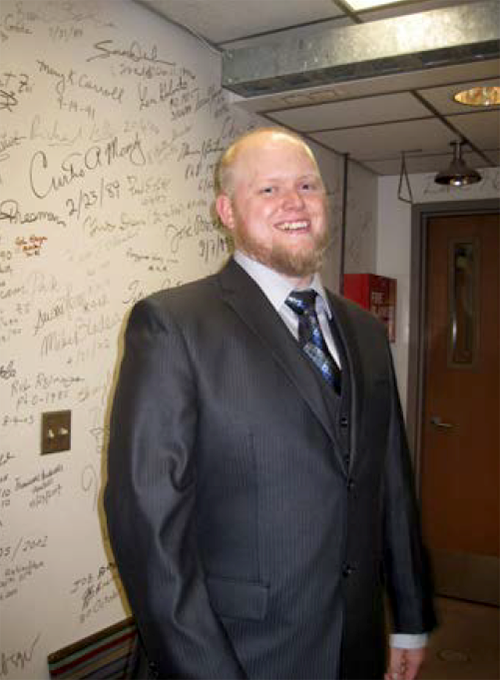
Future Prospects
Given Shelley’s excellent work to date, his colleagues look forward to the future developments of his career. Hieftje says that Shelley’s future includes, “more publications, outstanding students, additional awards, and a top international reputation.” Montes-Bayón believes Shelley’s knowledge of instrumentation physics will propel him forward in plasma spectroscopy. Ray’s vision focuses on MS, and teaching. “I expect Jake to continue to do great work in mass spectrometry, and to mentor the next generation of leaders in spectrometry,” he said, describing Shelley as dynamic, hard-working, and insightful.
Engelhard anticipates Shelley’s expansion into other areas. “I think that we will see Jake blossom as he expands his research interest into other types of mass spectrometry, optical spectroscopy, instrumentation, and automated data processing,” he said. Marcus takes an even broader view, believing that Shelley’s career will lead to “putting together the varied experiences of his past, to produce totally-new measurement tools.” Cooks expects Shelley to continue in the proud tradition of Gary Hieftje and Indiana University. “I look forward to watching his future successes.”
Chan, in turn, sees no bounds, “For Jake, the sky is the limit,” he said.
References
- J.T. Shelley and G.M. Hieftje, J. Anal. At. Spectrom.25(1), 345–350 (2010).
- G.C.Y. Chan, J.T. Shelley, J.S. Wiley, A.U. Jackson, C. Engelhard, R.G. Cooks, and G.M. Hieftje, Anal. Chem.83(10), 3675–3686 (2011).
- J.S. Wiley, J.T. Shelley, and R.G. Cooks, Anal. Chem.85(14), 6545–6552 (2013).
- S.P. Badal, S.D. Michalak, G.C-Y Chan, and J.T. Shelley, Anal. Chem.88(7), 3494–3503 (2016).
- J.T. Shelley, S.P. Badal, C. Engelhard, and H. Hayen, Anal. Bioanal. Chem.410(17), 4061-4076 (2018).
- A.J. Schwartz, J.T. Shelley, C.L. Walton, K.L. Williams, and G.M. Hieftje, Chem. Sci. 7, 6440–6449 (2016).
- G.M. Hieftje, S.J. Ray, K.P. Pfeuffer, J.T. Shelley, and N.J. Caldwell, Indiana University Research and Technology Corp., Ambient sampling mass spectrometry and chemometric analysis for screening encapsulated electronic and electrical components for counterfeits. U.S. Patent 9,607,306 (2017).
- Z. Yue, H. Wang, D.J. Bowers, M. Gao, M. Stilgenbauer, F. Nielsen, J.T. Shelley, and Y.R. Zheng, Dalton Trans.47(3), 670–674 (2018).
- I. Ayodeji, T. Vazquez, L. Song, J. Donovan, T. Evans-Nguyen, S.P. Badal, G.M. MacLean, and J.T. Shelley, Int. J. Mass Spectrom.438, 157–165 (2019).
- Y. You, S.P. Badal, and J.T. Shelley, J. Am. Soc. Mass Spectrom. 30(9), 1720–1732 (2019).
- C. Kuhlmann, J.T. Shelley, and C. Engelhard, J. Am. Soc. Mass Spectrom.1-13 (2019). doi.org/10.1007/s13361-019-02280-w
Jerome Workman, Jr. is the Senior Technical Editor of Spectroscopy. Direct correspondence to jworkman@mmhgroup.com
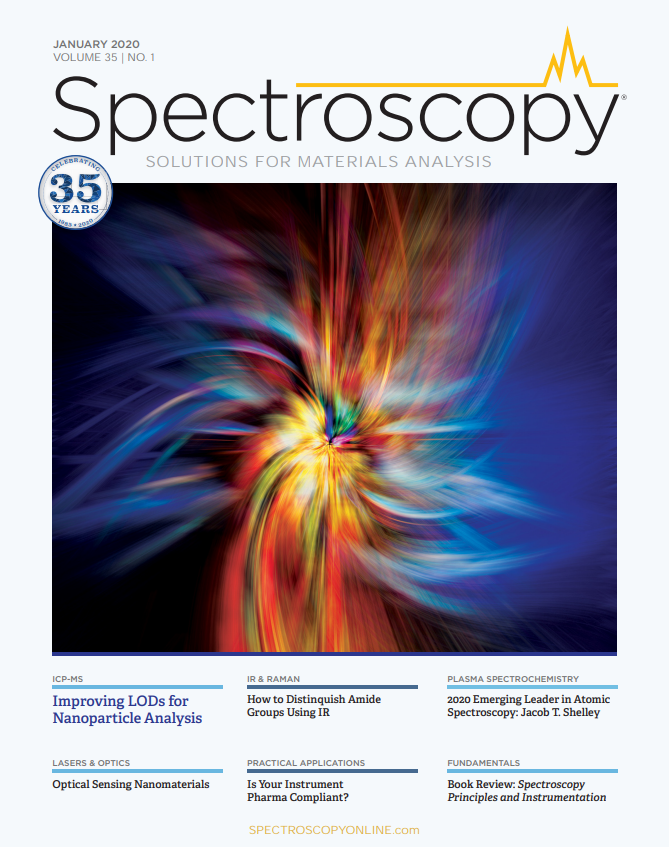
New Study Reveals Insights into Phenol’s Behavior in Ice
April 16th 2025A new study published in Spectrochimica Acta Part A by Dominik Heger and colleagues at Masaryk University reveals that phenol's photophysical properties change significantly when frozen, potentially enabling its breakdown by sunlight in icy environments.